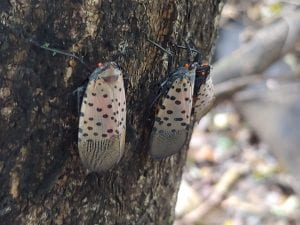
Spotted Lanternfly Adults
The Spotted Lanternfly (Lycorma delicatula) (SLF) is currently in the adult stage, and can remain active as adults until our first frost this fall. It is often in this stage that it captures attention because of its size and uniqueness, and Ohioans are taking notice. In recent weeks, several SLF finds have been reported. These reports include single finds where individual adults were seen outdoors, and locations where numerous insects where found in what has been defined as reproducing populations.
If you suspect you are seeing SLF, whether it is one or many, we would like you to collect it. The collection could be the actual specimen in a container, or its image with a camera or phone.

Reports can be made to the Ohio Department of Agriculture (ODA) on their website, by emailing or calling. Information can be found on their website at: ODA, SLF Webpage Additionally, suspect reports can also be made using the Great Lakes Early Detection Network App. This free smartphone app can be downloaded and used to report a variety of invasive species including SLF.
Early detections of SLF will help Ohioans manage populations that can ultimately reduce the impact caused by this invasive species and lessen levels that can become a nuisance.
We realize if you are helping us look for SLF, you may see other insects that could be confused with SLF. Check out this resources created by Virginia Tech to highlight some look-alikes.
spotted-lanternfly-look-a-likes



